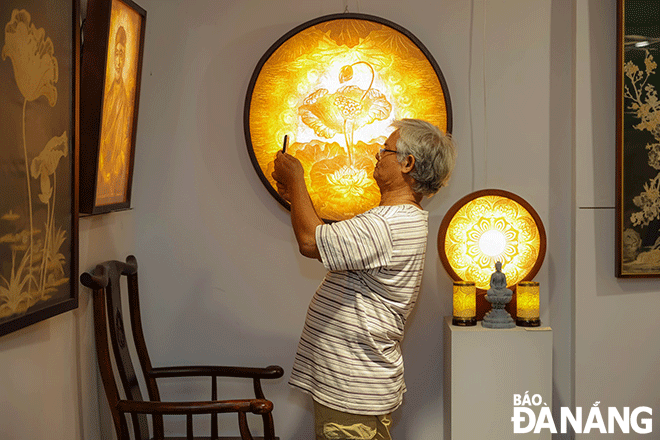Truchigraphy artworks hold a surprise for Da Nang's viewers
Fifty-two Trucchigraphy artworks which were on display at the Da Nang Fine Arts Museum from July 14 -31 surprised and delighted the city’s art lovers with their fresh, luxurious, delicate and emotional features.
 |
| Art lovers are fascinated by Trucchigraphy artworks. Photo: T.Y |
A distinct style of paper-art
The name trucchigraphy stems from the Sino-Vietnamese term ‘truc chi,’ which directly translates to 'bamboo paper.' The name trucchigraphy revolves around embossing and debossing paper made from the fibers of bamboo.
While admiring a trucchigraphy artwork named Loc Xoay (Vortex) created by artist Nguyen Phuoc Nhat, Mr. Nguyen Van Viet, a resident of Thuan Phuoc Ward, Hai Chau District remarked that this is the first time he has known about trucchigraphy. The vivid artwork, depicting a school of fish struggling to swim out of a whirlpool was attractive to him due to its perfect lighting effects and art installation.
“The images which are depicted on trucchigraphy artworks are quite familiar with Vietnamese viewers, especially those from Da Nang, including butterflies, lotus flowers, lily-of-the-valley flowers, rice grains, rural memories. The images bring a deep sense of peace and relaxation to me while admiring them," Viet said.
Painter Ngo Dinh Bao Vi, the Director of Trucchi Art Vietnam Co., Ltd., said that having been started to create in 2000 by artist Phan Hai Bang and his colleagues at the Hue University based in Thua Thien-Hue Province, trucchigraphy is a relatively modern art form, though the traditional methods trucchigraphers use to make paper from bamboo fibers have been around for much longer.
For ten years, artist Phan Hai Bang and his team members have devoted themselves to successfully developing Trucchigraphy imbued with Hue’s cultural identity.
Aside from bamboo, Bang and his team also created trucchigraphy from agricultural waste including bagasse, straw, and corn stalks, as well as the natural fibers from water hyacinth.
Creating trucchigraphy starts with making the paper. Agricultural waste is used as raw materials for pulp extraction. Artists then put the pulp into water, and use a mould and deckle to shape the pulp and create layers of paper. Afterwards, a high-pressure water nozzle is utilized to spray water on the wet paper and ‘sculpt’ imagery.
Differences in the thickness of certain details help to give rise to different effects when light interacts with the piece. The last step in the trucchigraphy process is to dry the work.
This art, different from other arts that paper only serves as the background to highlight the patterns, features the paper only.
According to painter Vi, trucchigraphy is a new form of Viet Nam’s paper art. Bamboo paper has escaped from its status which is used for the background of creative works to become an independent art form. Truc chi is not only the art of paper making, it is the combination of tradition and creativity. The passion drives the artists to create a new kind of unique and creative art.
Truth, Goodness, and Beauty in Trucchigraphy
Painter Nguyen Phuoc Nhat, the Deputy Director of Vietnam Bamboo Art Company Limited who contributes to bringing Trucchigraphy closer to the public, said that Trucchigraphy artworks initially only exploited the patterns and motifs of bamboo, reed, sugarcane, straw, corn stalks, water hyacinth and more. Artists then created more familiar, and human-oriented artworks in accordance with 3 criteria namely aesthetics, education and society. Trucchigraphy is not only limited to creative activity in the fine arts, but also opens up new perspectives in the techniques and applications of computer graphics, and visual arts as a whole.
Trucchigraphy features a bit classical sense of art but showcase the perfect combination of visual and applied arts. Truc chi is used to create handicraft and decorative items such as partitions, screens, umbrellas, cards, conical hats and fans.
Painter Phan Hai Bang affirmed that artists’ ideas and creativity help to create their own original and unique artworks. Therefore, their artworks not only bring an aesthetic pleasure to the viewers, but also contribute to motivating and energizing artists, as well as cultivating positive energy to themselves.
Reporting by TIEU YEN – Translating by H.L